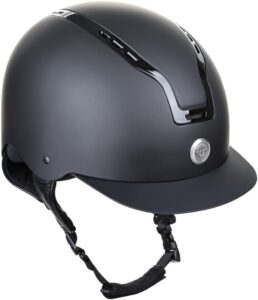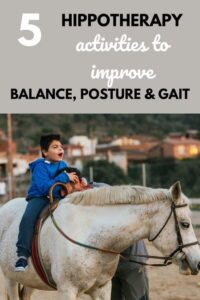
Learn all about the top safety tips for hippotherapy. Putting someone with a medical condition or disability on horseback might sound terrifying, but hippotherapy is actually a proven and safe treatment method.
Discover the stringent safety measures implemented to ensure everyone’s well-being.
This post was created by Marra Robert, OTD, OTR/L and contains affiliate links.

Seeing a horse for the first time up close can be a powerful experience.
They are one of the most beautiful animals in the world and also one of the most powerful creatures that we interact with on a regular basis. They can also be used as a powerful treatment strategy in hippotherapy
FIRST, WHAT IS hippotherapy?
Hippotherapy refers to how occupational therapy, physical therapy, and speech-language pathology professionals use evidence-based practice and clinical reasoning in the purposeful manipulation of equine movement to engage sensory, neuromotor, and cognitive systems to achieve functional outcomes.
In conjunction with the affordances of the equine environment and other treatment strategies, hippotherapy is part of a patient’s integrated plan of care.
The idea of putting someone on horseback with a medical condition such as a spinal cord injury, traumatic brain injury, intellectual disability, or a child with a developmental disability might sound terrifying.
I encourage you to read on and learn more about the safety tips for hippotherapy before dismissing the idea altogether. Remember, in order to change, we need to be courageous and a little uncomfortable at times.
There is growing evidence that supports how beneficial hippotherapy can be to improve the well-being of the clients.
The therapists and horses involved are highly trained and exercise many safety rules and procedures to ensure that the rider’s safety as well as the safety of everyone involved is maintained at all times.
7 safety tips for hippotherapy
Helmets

By far, the most important safety tip for hippotherapy is to ensure that the client is always wearing a helmet when they are on or around the horse.
It is important that the helmet be an equestrian helmet that is SEI certified. SEI (Safety Equipment Institute) is a set of standards and safety regulations for helmets and other safety equipment.
If the rider falls and hits their head with the helmet, then the helmet is no longer considered safe.
For very young clients or clients with postural instability causing the added weight of a SEI certified helmet to increase head instability, lightweight helmets may be substituted if in the judgment of the therapist, a lightweight helmet is better and safer for the client.
Horses
The next safety tip for hippotherapy involves the horse. Therapeutic horses are specially trained horses that are used in the treatment process.
They must go through an extensive amount of training and desensitization to common treatment activities that are different from normal horse experience before they are used during the hippotherapy session.
Even though the horses are trained and selected for hippotherapy, everyone working with or around the horse must take safety precautions at all times.
The therapist does not need prior experience with horses to provide this type of treatment to clients however there needs to be at least one person on or supporting the treatment team who is knowledgeable about horses and certified as a riding instructor (if the treatment occurs in a PATH accredited site).
The client and the horse must be under the supervision of the therapist at all times.
If the client demonstrates negative behaviors around the horse that compromises the safety of the horse, client, or team member, then the therapist and client can work on their behaviors in a separate area away from the horses until the client is better able to manage behaviors.
If the horse demonstrates negative or unsafe behaviors, the client should be removed from the horse immediately. Safety for all involved is the most important consideration during the hippotherapy session.

SIDEWALKERS
Sidewalkers are very important safety tips for hippotherapy. Their role is maintaining the safety of the client and assisting the therapist while clients are on the horse.
Typically there is a sidewalker on each side of the client next to the horse who is in constant contact with both the client and the horse. Clients may require fewer sidewalkers or varying amounts of support depending on their needs and the treatment activity.
Sidewalkers must go through training before they can participate in the treatment session. During the training they learn about the hippotherapy and various methods to keep the client safe and support the therapy goals.
Horse Handeler/Leaders
The use of horse handlers are an essential safety tips for hippotherapy. The horse handler are part of the treatment team and makes it possible to use the horse in a therapeutic setting.
The leader leads the horse throughout the session following instructions from the therapist on speed, gait, cadence, and direction. They also play an important role in ensuring the client’s safety throughout the session.
They must go through leader training to learn about hippotherapy and related horse handling skills. It is important that the leader has demonstrated significant horse handling experience and has received specific training in leading for therapy before they participate in the hippotherapy treatment session.

Gait Belts
Gait belts are also important safety tips for hippotherapy. Gait belts are for clients to wear when they are around or on the horse. It is useful for helping the client transfer on and off the horse as well as staying centered while they are on the horse.
They are also important to help with emergency dismounts if needed. There are different types and sizes of belts available depending on the needs of the client.
Belts designed for equestrian use are not typical gait belts. Grab belts usually have one or two handle loops to provide therapists and sidewalkers a quick and easy place to grab in case of an emergency or to assist in movements, change of position or mounting/dismounting.
Transfers
Transferring the client on and off of the horse during a hippotherapy session can be challenging depending on the client’s abilities. Often, it is best to use a mounting block in the ring where the session will take place.
Before transferring the client onto the horse the therapist must ensure that they are wearing both an appropriate helmet and grab belt.
There should be sidewalkers on both sides of the horse to help with the transfer and to ensure that the client is safe. If the client uses a wheelchair or has other physical impairments, using a ramp may be necessary for the transfer.
The horse must be properly trained and comfortable with being confined between the two sides of a ramp and the ramp transfer prior to the session.
Also, everyone on the treatment team must understand how to use the ramp for the transfer. Lifts may also be used with the ramp for transfers.
Again, the therapist (with possible assistance from a riding instructor as a partner to the therapist) has the primary responsibility to ensure that the treatment team and horse are comfortable with the transfer prior to the hippotherapy session.
Safe Footwear
Sidewalkers and any other person, including parents or family members involved in the treatment or present in the arena, must wear shoes or boots that cover the feet completely, no sandals, open toes, or flip-flops are allowed in the arena.
Hippotherapy is a safe and effective treatment strategy that improves the lives of many every day. Please comment below or reach out with any questions, concerns, or if you are interested and would like more information.
